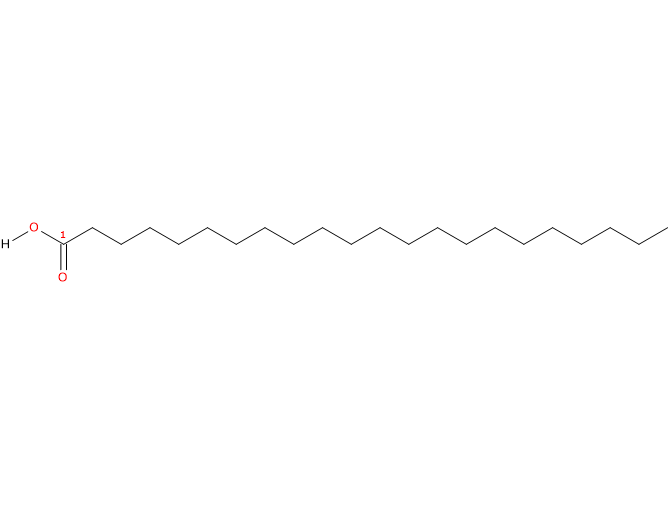Behenic acid (22 carbon atoms) is a major component of Ben oil, also known as behen oil or Moringa oil (first reported by Voelcker A. in 1848), which is extracted from the seeds of Moringa oleifera and is used in cosmetics.
The name “behenic” derives from the Persian mount Bahman, where the seeds of this tree were harvested.
It belongs to the group of saturated fatty acids (no double bond, so its shorthand notation is 22:0). It is also a member of the group called very long chain fatty acids (VLCFA), from 20 carbon atoms onwards.
PROPERTIES
Molecular weight: 340.58356 g/mol
Molecular formula: C22H44O2
IUPAC name: docosanoic acid
CAS registry number: 112-85-6
PubChem: 8215

In purified form it is a white to yellowish waxy solid, with melting point at 79.95 °C (175.91 °F; 353.1 K) and boiling point at 306 °C (582.8 °F; 579.15 K) at 60 mm Hg.
A curiosity: it is often used to give hair conditioners and moisturizers their smoothing properties.
OTHER NAMES
docosoic acid
1-docosanoic acid
N-docosanoic acid
22:0
Food sources of behenic acid
Behenic acid is found in small quantities, as an ester of glycerol, only in certain fats and oils.
Fresh red and white meat do not contain this compound.
Processed and preserved meats are generally devoid of it, with the exception of some types of ham, where it is present in minimal amounts—for instance, 0.01 g/100 g of the edible portion in San Daniele ham, or in trace levels in Parma ham.
Milk and dairy products, including butter, do not contain behenic acid.
Eggs are also free of this compound.
In fishery products, it appears in very small quantities exclusively in the belly of tuna in brine, at a concentration of 0.01 g/100 g of the edible portion.
On the contrary, it is present in appreciable quantities in a few vegetable fats and oils:
- the highest amount is found in peanut oil, 3.25 g/100 of edible portion; small amounts are present in wheat germ oil and olive oil, 0.1 and 0.09 g/100 g of edible portion, respectively;
- peanut butter contains 1.28 g/100 g of edible portion; it is absent in margarine.
Behenic acid is not present in cereals and cereal products.
Fruit, including dried oily varieties, does not contain this compound.
While absent in fresh and dried legumes, it is found in small amounts in soy meal, with a concentration of 0.02 g/100 g of the edible portion.
References
- Akoh C.C. and Min D.B. “Food lipids: chemistry, nutrition, and biotechnology” 3th ed. 2008
- Chow Ching K. “Fatty acids in foods and their health implication” 3th ed. 2008